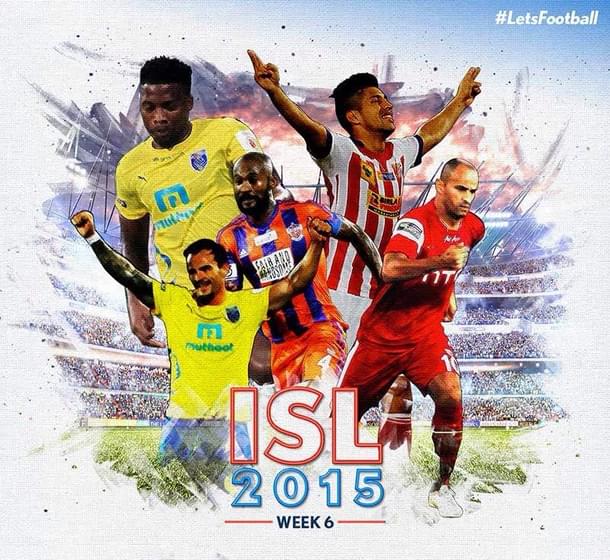Culture
Here's What The Indian Super League Has Done For Indian Football
Rashi Kakkar
Nov 17, 2015, 10:42 PM | Updated Feb 12, 2016, 05:28 PM IST
Save & read from anywhere!
Bookmark stories for easy access on any device or the Swarajya app.


The Indian Super League (ISL) has managed to ignite the passion of fans – not so much for specific ISL teams as much as for Indian football.
At its very core, sports help unite people. For a sport to do this, it first needs to divide people. While this might seem extremely paradoxical this division is a critical requirement as it adds the most important ingredient a sport needs to become successful – passion. Passion for the two competing sides divides the fans and then eventually that shared passion for the sport itself unites all the fans under a bigger umbrella.
Viewed from that lens, the Indian Super League (ISL) has managed to ignite the passion of fans – not so much for specific ISL teams as much as for Indian football. There are two camps that have emerged – those that consider the ISL the knight in shining armor that will save Indian football and those that look at ISL as nothing but a money making gimmick.
“The ISL is solving some problems and not solving some” says 22 year old Aarish Ansari a professional football freestyler (crew ‘Footrix’) who worked closely with the Mumbai City FC in the inaugural season. During the half time he did football freestyle shows for them in all their home matches. He witnessed the ISL from within the ground and mentions-
The atmosphere in ISL matches is totally different from I-League matches. It feels like an EPL or La Liga match and this in turn has still managed to pull in more people to the stadium than its poor cousin the I League….
Anubhav Roda, a Sports Management professional who has worked with the biggest youth football league in India- Delhi Youth League too believes that the greatest positive of the ISL is the celebratory atmosphere it has created around Indian football –
The ISL came in as an exciting property and the marketing was such that it caught the attention of everyone. The ISL is basically a brilliantly marketed product which isn’t much higher than the I-League in terms of the level of football.
And according to Anubhav that is where the league falls flat
The ISL is trying to speak to the large urbane football audience in the country which is thriving on European football. The only thing that will pull these people in to watch the ISL is better quality play.
Anukul Thakur, a football lover who currently works with the Madison creative team also feels that to compensate for the lack of quality on the pitch the ISL has indulged in a certain level of buffoonery-
I wish they would stop creating a mockery of the game with Bollywood celebrities. It puts off a serious fan when you see the game being treated as a charity event. This is costing them hardcore passionate fans. The needless celebrity involvement, interviews in between games and an IPL style format is a huge turn off.
However Kartik S. Menon, a Young India Fellow, and a self confessed non-fan of the league still feels that an India with an ISL is still better than an India without it-
Despite the fact that I do not find ISL exciting, I still feel that this is a step in the right direction. ISL certainly has given a platform to a bunch of exciting talents to come to the forefront and showcase their skills. I believe that the star players would help the youngsters acquire some footballing sense while managers like Zico could help bring in some good tactical knowledge as far as training, formations, style and game play is concerned, which could then be imbibed by the players and replicated on the international scene. While ISL will not be an end in itself, it certainly is a means to make a small but sure change in the way the game is played in the country. I also think that ISL could also help in bringing a cultural change in the way people in India see and feel about football.
“I like the fact that they are getting big names to promote the game” says Nikhil Mahen an engineering management graduate of Duke University –
This paradigm has seen benefits in the US with MLS (Major League Soccer) becoming more and more popular. In fact, when I was in the US I went to see New York Red Bulls play Toronto just to see Henry play. I would suggest that we study the Major League Soccer model of the USA closely. It offers us considerable insights into introducing and popularizing a game in a country where hardly anyone plays it. When MLS came to the US, baseball and basketball ruled the roost. The league experienced considerable roadblocks in the initial years, mostly on account of the organizers trying to “Americanize” the sport which alienated a lot of fans. Similar attempts by the ISL organizers to give an IPL flavor to the games should be dissuaded.
Sumit, who is currently pursuing his MBA at the University of Oxford’s Said Business School is optimistic about the ISL and its potential to make Indian football popular. The aspect of ISL that he truly appreciates is one in which it is trying to promote grass root football-
Imparting football knowledge to young children and in the right manner is a very important factor in determining whether India will succeed as a footballing nation or not. I sincerely hope that the ISL franchisees and the owners IMG-Reliance continue to take the act of development of youth football very seriously, and that in my eyes would be the true contribution of ISL towards football development in India.
Most people I spoke to had dramatically varying opinions about the ISL but what they all had in common was a shared frustration at the lack of improvement in Indian football. Some of the action steps that came out of our conversations were:
Short term solutions:
- ISL matches should be kept on Fridays and Saturdays only. Keeping certain days for the game helps create a routine and has the perfect waiting ratio to keep people hooked to the game on certain days. Take for example American Football, all European football leagues, Formula 1 racing etc all have huge followings and all happen at a set time on the weekends when everyone can sit in front of the TV and enjoy. It becomes a ‘thing to do’ or part of the routine.
- Create more interesting discussions and content around the game. Not the kind where individual teams are celebrated but following the whole movement of the ball, the way defense is stretched, more detail on team tactics etc. That not only educates the viewers about the game but keeps the conversation more interesting pre and post the game.
- Improve the fan experience and stadium infrastructure. This is important in setting the environment for the viewer when at the stadium and at home as the game looks more festive. The experience of watching a good game should be like watching a great movie in the comfort of a spectacular theater.
Long term solutions to focus on the quality of Indian football:
- In the long run the ISL and I-league need to be merged – One nation one league. Then India can have one proper league that goes on for 7-8 months.
- A stronger push on youth development and women’s football as well as getting parents involved to create a football ecosystem. In the current system most ISL clubs conduct 1 day festivals at schools or academies and claim that this is a part of the grassroots program stating that they touched 5000-10000 kids. This needs to be changed and it should be mandatory for every club to nurture at least three youth teams (U14, U16, U19) from its academy participating in parallel leagues with other such teams. There needs to be scouting, academies running across age groups, youth level leagues and coach training programs.
- Professionalize the administration and management of Indian football. They need to understand the key elements of Indian football and have a realistic vision of the milestones which can be achieved.
Both the pro and anti ISL camps have great points to make. The AIFF needs to engage in discussions with both parties, cut the noise and take the meat from the conversations and implement it to help Indian football succeed. The ISL may not be the golden bullet that will solve Indian football’s problems but atleast it has got people interested enough to start talking about potential solutions.
To me this, the deep divide that ISL has created amongst fans, is good news. At the very least what the ISL has done is bring conversations about Indian football into Indian popular culture. Thanks to the pro and anti ISL debates the average Indian knows about Indian football, the players and what is at stake. This probably is ISL’s greatest achievement in the last one year.
Rashi Kakkar is a graduate from The Shri Ram College of Commerce, New Delhi, and a Young India Fellow. Currently she works as a brand consultant and is enjoying this marriage of her two biggest passions – Strategy and Branding. A junior national level tennis player, Rashi is a complete sports buff who enjoys playing and watching any and every sport. She tweets @rashi_kakkar





